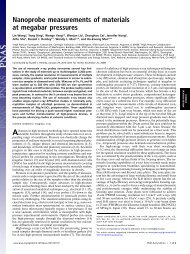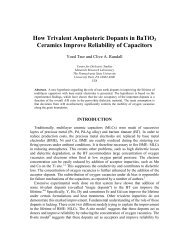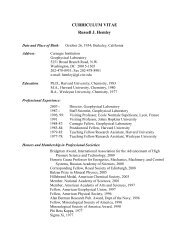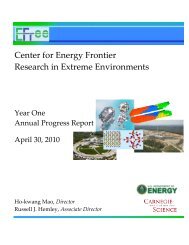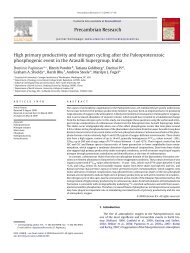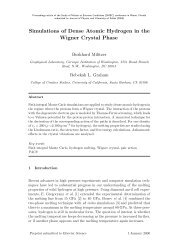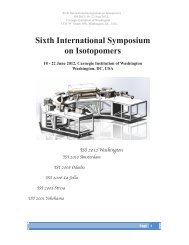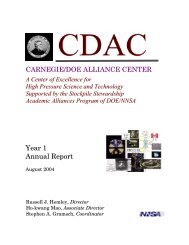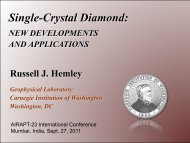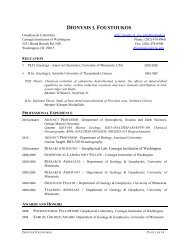Herd C. D. K., A. Blinova, D. N. Simkus, Y. Huang, R. Tarozo, C. M. O ...
Herd C. D. K., A. Blinova, D. N. Simkus, Y. Huang, R. Tarozo, C. M. O ...
Herd C. D. K., A. Blinova, D. N. Simkus, Y. Huang, R. Tarozo, C. M. O ...
Create successful ePaper yourself
Turn your PDF publications into a flip-book with our unique Google optimized e-Paper software.
REPORTS<br />
characteristics cover the range seen in the other<br />
three specimens. The macroscopic differences<br />
among the specimens are attributable to the proportions<br />
of the various components, as well as<br />
matrix grain size. For example, 11i, which is very<br />
dark and tends to shed a residue of black dust, has<br />
a lower proportion of chondrules and a smaller<br />
average matrix grain size ( 11h ><br />
11i ~ 11v (Table 1). The variations in H/C and dD<br />
observed in IOM in these specimens span almost<br />
the entire range found among the different carbonaceous<br />
chondrite groups (Fig. 1A). This lends<br />
credence to the suggestion that the variation in<br />
IOM elemental and isotopic compositions found<br />
in chondrites is the result of parent body modification<br />
of a common precursor (8). Furthermore,<br />
there is a linear correlation between H/C<br />
ratios and dD values (Fig. 1). Solid-state 13 Cand<br />
1 H nuclear magnetic resonance spectroscopy and<br />
carbon x-ray absorption near-edge spectroscopy<br />
[C-XANES (24)] (13) indicate that the decrease<br />
in the H/C ratio is accompanied by an increase in<br />
the proportion of aromatic C in the IOM as well<br />
as a considerable increase in aromatic substitution,<br />
probably aromatic condensation (13). The<br />
change in H/C was not accompanied by a substantial<br />
loss of C (Table 1), which may indicate<br />
that the aliphatic component in the Tagish Lake<br />
meteorite was converted into aromatic C, while<br />
undergoing H isotopic exchange with the altering<br />
fluid and/or preferential D loss. This apparently<br />
facile transformation is unexpected. It is most<br />
likely caused by hydrothermal alteration, as is observed<br />
in experiments involving hydrous pyrolysis<br />
or reaction with water at elevated temperature and<br />
pressure (11, 25), and differs from the scenario in<br />
which aliphatic C is selectively removed through<br />
reaction with an oxidant (26).<br />
High-spatial-resolution secondary ion mass<br />
spectroscopic (SIMS) measurements reveal that<br />
the isotopic differences observed in bulk IOM<br />
residues extend to submicrometer scales. IOM<br />
from sample 5b shows not only a higher average<br />
D/H ratio but also a much higher proportion of<br />
very D-rich submicrometer-sized isotopic hot<br />
spots (Fig. 1B) with more extreme D/H ratios<br />
than those from 11v [maximum dD ~20,000 per<br />
mil (‰) in 5b versus ~7000‰ in 11v]. These<br />
observations suggest that parent body alteration<br />
has substantially removed D, decreasing the D/H<br />
ratio on all spatial scales and reducing the number<br />
of hot spots. Similar variations in D enrichments<br />
and abundances between chondrites have been<br />
observed before, but never in a single chondrite.<br />
In contrast, the N isotopic distributions are similar<br />
except that 5b contains about twice the number<br />
density of 15 N hot spots (with d 15 N in both<br />
residues up to ~800‰). This difference in behavior<br />
of H and N isotopes supports observations<br />
in previous studies that D and 15 N enrichments in<br />
IOM tend to be decoupled (5). Isotopic hot spots<br />
are, in many cases, associated with carbonaceous<br />
nanoglobules (5, 20). Transmission electron microscope<br />
(TEM) examinations indicate that IOM<br />
from sample 5b has a significantly higher fraction<br />
(7.5%) of nanoglobules than does IOM from 11v<br />
(0.9%) (13). C-XANES (24) indicates the presence<br />
of two chemical classes of nanoglobules,<br />
one with a C functional group distribution similar<br />
to that in nonglobular IOM and one dominated<br />
by aromatic functionality (13). Aromatic-type nanoglobule<br />
spectra are seen in a higher fraction of<br />
nanoglobules from 11v as compared to 5b [50%<br />
versus 20% (13)]. Taken together, the SIMS,<br />
TEM, and XANES results suggest that 15 N-rich<br />
nanoglobules have been preferentially destroyed<br />
in specimen 11v by hydrothermal alteration. Moreover,<br />
the higher fraction of highly aromatic nanoglobules<br />
in the more altered sample supports the<br />
conclusion from the bulk data that the alteration<br />
largely affects the aliphatic component of<br />
the IOM.<br />
Based on IOM results, the degree of alteration<br />
reflected by the Tagish Lake specimens is 5b <<br />
Fig. 1. (A)PlotofH/C,a<br />
measure of the degree of<br />
aliphatic character, against<br />
H isotopic composition for<br />
the Tagish Lake specimens,<br />
including data on the Tagish<br />
Lake meteorite from<br />
previous work (8). Also<br />
shown are representative<br />
data from other chondrite<br />
groups after (8), including<br />
ordinary chondrites (OC).<br />
For reference, the H/C value<br />
of an aliphatic molecule<br />
with infinite chain length<br />
is 2; aromatic organic matter has a maximum H/C = 1 (benzene), and approaches low values (~0.1) as the<br />
number of fused aromatic rings approaches infinity. (B) MapsofdD/H values of IOM separates from Tagish<br />
Lakespecimens5band11v,derivedfromHandDraster ion images acquired with a Cameca NanoSIMS 50L<br />
ion microprobe.<br />
11h < 11i < 11v, which is consistent with the<br />
order inferred petrologically. Within this context,<br />
we examined the results of the SOM analysis to<br />
determine whether the hydrothermal alteration<br />
has resulted in the formation, modification, or<br />
destruction of soluble organic molecules and to<br />
elucidate the relationship between IOM and<br />
SOM during the alteration.<br />
MCAs dominate the water extracts of the<br />
Tagish Lake meteorite. MCAs, such as formic<br />
and acetic acids, play essential roles in biochemistry<br />
(11, 27, 28); higher homologs are the fatty<br />
acids that self-assemble into membrane-bound<br />
vesicles in meteorite extracts and are the possible<br />
precursors of cell membranes (29). We identified<br />
11 MCAs in all specimens, including most of the<br />
members of the homologous series of linear,<br />
saturated MCAs from C 1 to C 10 . One or two<br />
branched isomers were detected in all specimens<br />
with the exception of 5b, in which 17 branched<br />
isomers were detected, in addition to the 11 linear<br />
MCAs. Numerous alkyl-substituted phenols were<br />
also found exclusively in 5b. Although, as in previous<br />
studies, d 13 C values are generally consistent<br />
with terrestrial values, these MCA hydrogen<br />
isotopic compositions are D-enriched, consistent<br />
with an extraterrestrial origin (2): As measured in<br />
5b, dD (acetic), 247‰; dD (formic/propanoic),<br />
708‰; dD (butanoic), 562‰; dD (isopentanoic),<br />
697‰ (13). The observed concentrations of these<br />
low-molecular-weight MCAs are unusually high<br />
relative to those seen in other studies of carbonaceous<br />
chondrites [including Tagish Lake (18)],<br />
ranging from 42 to 250 parts per million (ppm)<br />
for formic and acetic acid (13). We attribute these<br />
large concentrations to the preservation of the<br />
meteorite below 0°C since its recovery, which<br />
has minimized the loss of volatile organics, such<br />
as formic acid, as well as the specifics of the<br />
analytical methods (13). In nearly all specimens,<br />
the concentrations of the straight-chain MCAs<br />
decrease in a logarithmic manner as the C number<br />
increases, with the exception of 5b, in which<br />
the acetic acid concentration exceeds that of formic<br />
acid. The d 13 C values of MCAs differ among the<br />
specimens (Fig. 2). All specimens have common<br />
d 13 C~–20‰ for formic acid, and higher homologs<br />
approach a constant value of ~ –5‰ (average<br />
nonanoic acid = –26 T 2‰) with increasing C<br />
number. The largest differences are observed<br />
in acetic acid, which ranges from +8‰ (11h)<br />
to –36‰ (5b). Of particular note is specimen 11h,<br />
which shows a decrease in d 13 C with increasing<br />
C number (Fig. 2).<br />
The differences in MCAs among the Tagish<br />
Lake specimens may be explained by differing<br />
degrees of parent body modification. With the<br />
exception of formic acid, specimens 5b and 11h<br />
contain the highest concentrations of MCAs, 2 to<br />
10 times greater than concentrations in 11i and<br />
11v (13), attributable to loss or destruction of<br />
these water-soluble compounds during progressive<br />
parent body alteration. The high proportion<br />
of branched isomers in specimen 5b suggests that<br />
it preserves a more primary suite of compounds<br />
Downloaded from www.sciencemag.org on June 9, 2011<br />
www.sciencemag.org SCIENCE VOL 332 10 JUNE 2011 1305



